The Effect of Peer Learning Strategy on Students' Learning of the Skills of Serving and Hitting in Volleyball
DOI:
https://doi.org/10.64002/bnbw2h63Keywords:
Peer learning strategy, serving and smashing skills, volleyballAbstract
The study's problem focused on: Through the researcher's observation of volleyball lessons, he found many educational curricula that may not take into account individual differences among learners, nor do they consider the mental aspect of thinking, deduction, and analysis to reach a solution to the problem of performing a learned skill. Therefore, the problem of the study lies in the use of educational curricula for the peer learning strategy, and the researcher believes that it will contribute to solving the problem. The study aimed to: develop an educational curriculum using a peer learning strategy to teach students the skills of serving and smashing in volleyball; evaluate the effects of the educational curriculum in light of the peer learning strategy to teach students the skills of serving and smashing in volleyball.
Using an equivalent design for two groups and an experimental technique with pre- and post-tests, the main study population was determined as third-year students at the College of Physical Education and Sports Sciences at the University of Kufa, numbering (58) students, from whom the researcher selected (32) students.
The most important conclusions are: The peer learning strategy had a positive impact on learning and developing the skills of serving and smashing in volleyball. Furthermore, the time period during which the strategy was implemented significantly contributed to learning and developing the skills of serving and smashing in volleyball.
Downloads
Published
Issue
Section
License
Copyright (c) 2025 Damu Journal of Sport Sciences

This work is licensed under a Creative Commons Attribution 4.0 International License.








